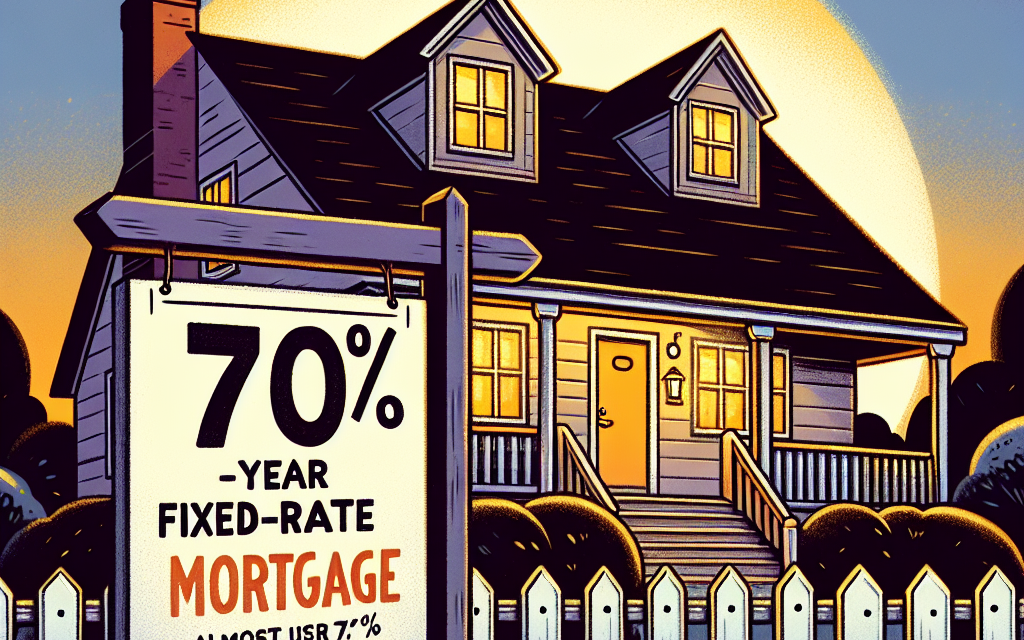“Lock in Stability: US 30-Year Fixed Mortgage Rates Hover Just Under 7%.”
Introduction
The US 30-year fixed-rate mortgage rate has recently stabilized just below the 7% mark, reflecting a complex interplay of economic factors, including inflation trends, Federal Reserve policies, and housing market dynamics. This rate is a critical benchmark for homebuyers and the real estate market, influencing affordability and purchasing power. As interest rates remain a focal point for potential homeowners and investors, the implications of this near 7% rate are significant, shaping decisions in the housing sector and broader economic landscape.
Current Trends in 30-Year Fixed-Rate Mortgages
As of late 2023, the landscape of the housing market continues to be shaped by the persistent hovering of the 30-year fixed-rate mortgage rate just under the 7% mark. This trend has significant implications for both prospective homebuyers and the broader economy. The stability of this rate, while seemingly modest, reflects a complex interplay of factors including inflation, Federal Reserve policies, and overall economic conditions.
In recent months, the Federal Reserve has maintained a cautious approach to interest rates, aiming to balance the need for economic growth with the imperative of controlling inflation. As a result, mortgage rates have remained relatively stable, albeit at levels that are higher than those seen in previous years. This stability has led to a sense of uncertainty among potential homebuyers, many of whom are weighing the benefits of purchasing a home against the costs associated with higher borrowing rates. Consequently, the decision-making process for these individuals has become increasingly nuanced, as they must consider not only the current rate but also the potential for future fluctuations.
Moreover, the current mortgage rate environment has prompted a shift in buyer behavior. Many prospective homeowners are opting for adjustable-rate mortgages (ARMs) as an alternative to the traditional fixed-rate option. This shift is largely driven by the desire to secure lower initial payments, which can be particularly appealing in a market where affordability remains a pressing concern. However, this choice comes with its own set of risks, as borrowers may face increased payments if interest rates rise in the future. Thus, while ARMs may offer short-term relief, they also introduce a level of uncertainty that many buyers must carefully consider.
In addition to influencing buyer behavior, the current mortgage rate trends are also impacting the housing supply. With rates hovering near 7%, many existing homeowners are reluctant to sell their properties and give up their lower-rate mortgages. This reluctance contributes to a constrained housing supply, which in turn exacerbates the affordability crisis in many markets. As demand continues to outpace supply, home prices remain elevated, further complicating the landscape for first-time buyers and those looking to upgrade their living situations.
Furthermore, the implications of these mortgage rate trends extend beyond individual buyers and sellers. The overall health of the housing market is closely tied to economic growth, and fluctuations in mortgage rates can have ripple effects throughout the economy. For instance, higher mortgage rates can dampen consumer spending, as individuals allocate more of their budgets toward housing costs. This shift can lead to reduced demand for goods and services, ultimately impacting businesses and employment levels.
In conclusion, the current trend of the 30-year fixed-rate mortgage rate hovering just under 7% encapsulates a multifaceted scenario that affects various stakeholders in the housing market. As potential buyers navigate this challenging environment, they must weigh their options carefully, considering both immediate financial implications and long-term economic forecasts. Meanwhile, the broader economic landscape remains sensitive to these developments, highlighting the interconnectedness of mortgage rates, housing supply, and overall economic health. As we move forward, it will be essential to monitor these trends closely, as they will undoubtedly shape the future of homeownership and the economy at large.
Impact of 7% Mortgage Rates on Homebuyers
As the US 30-year fixed-rate mortgage rate hovers just under 7%, the implications for homebuyers are significant and multifaceted. This threshold, while not unprecedented, marks a notable shift in the housing market, influencing both buyer behavior and overall market dynamics. For many prospective homeowners, the prospect of securing a mortgage at this rate can evoke a mix of anxiety and determination, as the financial landscape becomes increasingly challenging.
To begin with, a mortgage rate approaching 7% can substantially increase monthly payments, thereby affecting affordability. For instance, a homebuyer looking to purchase a $300,000 home would face a monthly payment of approximately $1,996 at a 7% interest rate, compared to about $1,264 at a 3% rate. This stark contrast illustrates how higher rates can limit the purchasing power of buyers, forcing them to reconsider their budget or the type of home they can afford. Consequently, many potential buyers may opt for smaller homes or seek properties in less desirable locations, thereby reshaping the demand across various segments of the housing market.
Moreover, the psychological impact of rising mortgage rates cannot be overlooked. As rates climb, potential buyers may feel a sense of urgency to act before rates increase further, leading to a rush in home purchases. Conversely, some buyers may adopt a wait-and-see approach, hoping for a decrease in rates or a stabilization of home prices. This duality in buyer sentiment can create volatility in the market, as fluctuations in demand can lead to unpredictable price movements. In this context, sellers may find themselves in a precarious position, as they must balance their desire to capitalize on current market conditions with the potential for a dwindling pool of buyers.
In addition to affecting individual buyers, the broader economic implications of sustained high mortgage rates are noteworthy. Higher borrowing costs can dampen overall housing market activity, leading to a slowdown in home sales. This slowdown can have a cascading effect on related industries, such as construction, home improvement, and real estate services. As fewer homes are sold, builders may scale back new projects, which can lead to job losses and reduced economic growth in regions heavily reliant on the housing sector. Furthermore, a stagnant housing market can exacerbate existing affordability issues, particularly for first-time buyers and low-income families who are already struggling to enter the market.
It is also essential to consider the impact of high mortgage rates on existing homeowners. Many homeowners who secured lower rates in previous years may feel disincentivized to sell their homes, as doing so would likely mean taking on a new mortgage at a higher rate. This reluctance can lead to a decrease in housing inventory, further complicating the market dynamics. As inventory tightens, competition among buyers can intensify, potentially driving prices up despite the higher borrowing costs.
In conclusion, the hovering 7% mortgage rate presents a complex landscape for homebuyers, characterized by increased monthly payments, shifting buyer behavior, and broader economic implications. As potential homeowners navigate this challenging environment, they must weigh their options carefully, considering both immediate financial impacts and long-term market trends. Ultimately, the interplay between mortgage rates, buyer sentiment, and housing supply will continue to shape the future of the real estate market in the United States.
Historical Comparison of Mortgage Rates Over the Decades
The landscape of mortgage rates in the United States has undergone significant fluctuations over the decades, reflecting broader economic conditions, inflation rates, and shifts in monetary policy. As the current 30-year fixed-rate mortgage rate hovers just under 7%, it is essential to contextualize this figure within the historical framework of mortgage rates. By examining the trends over the years, one can gain a deeper understanding of how today’s rates compare to those of the past.
In the 1970s, the U.S. experienced a period of rising inflation, which had a profound impact on mortgage rates. At the beginning of the decade, rates were relatively low, averaging around 7.5%. However, as inflation escalated, so did interest rates, culminating in a peak of approximately 18% by the end of the decade. This dramatic increase was largely a response to the economic turmoil of the time, including oil crises and a struggling economy. Consequently, many potential homebuyers found themselves priced out of the market, leading to a significant slowdown in housing activity.
Transitioning into the 1980s, the Federal Reserve, under the leadership of Chairman Paul Volcker, implemented aggressive monetary policies aimed at curbing inflation. These measures initially resulted in even higher mortgage rates, which reached their zenith in 1981. The average 30-year fixed-rate mortgage soared to an astonishing 18.45%, a figure that remains etched in the annals of financial history. However, as inflation began to subside, mortgage rates gradually decreased throughout the decade, providing some relief to homebuyers and stimulating the housing market.
The 1990s ushered in a new era of relative stability, characterized by lower inflation and a more favorable economic environment. Mortgage rates steadily declined, averaging around 7% by the end of the decade. This period of lower rates encouraged homeownership and contributed to a robust housing market, as more individuals were able to secure financing for their homes. The decade also saw the introduction of various mortgage products, including adjustable-rate mortgages, which offered borrowers more options in managing their financing.
As the new millennium approached, the early 2000s witnessed a further decline in mortgage rates, driven by a combination of economic growth and favorable monetary policy. By 2003, the average 30-year fixed-rate mortgage had dipped below 6%, making homeownership more accessible than ever. This trend continued until the financial crisis of 2008, which precipitated a dramatic shift in the housing market. In response to the crisis, the Federal Reserve implemented unprecedented measures, including lowering interest rates to near-zero levels, which resulted in historically low mortgage rates.
In the years following the crisis, mortgage rates remained low, often hovering around 3% to 4%. This environment fostered a housing recovery, as low borrowing costs encouraged refinancing and new home purchases. However, as the economy began to recover and inflationary pressures mounted, rates started to rise again, culminating in the current situation where the 30-year fixed-rate mortgage is just under 7%.
In conclusion, the historical comparison of mortgage rates reveals a complex interplay of economic factors that have shaped the housing market over the decades. While today’s rates may seem high compared to the lows experienced in recent years, they are still significantly lower than the peaks witnessed in the late 20th century. Understanding this historical context is crucial for both potential homebuyers and policymakers as they navigate the ever-evolving landscape of mortgage financing.
Strategies for Homebuyers in a High-Rate Environment
In the current economic landscape, where the US 30-year fixed-rate mortgage rate hovers just under 7%, homebuyers face unique challenges and opportunities. As interest rates remain elevated, potential buyers must adopt strategic approaches to navigate this high-rate environment effectively. Understanding the implications of these rates is crucial, as they directly influence monthly payments and overall affordability. Consequently, homebuyers should consider various strategies to mitigate the impact of high mortgage rates on their purchasing power.
One of the most effective strategies is to enhance one’s credit profile before applying for a mortgage. Lenders typically offer better rates to borrowers with higher credit scores, as they are perceived as lower risk. Therefore, homebuyers should take proactive steps to improve their credit scores by paying down existing debts, ensuring timely bill payments, and correcting any inaccuracies on their credit reports. By doing so, they may qualify for more favorable loan terms, which can significantly reduce the long-term cost of borrowing.
In addition to improving credit scores, homebuyers should also explore different mortgage products. While the 30-year fixed-rate mortgage is a popular choice, it may not always be the most advantageous option in a high-rate environment. Adjustable-rate mortgages (ARMs), for instance, often start with lower initial rates that can provide substantial savings in the early years of homeownership. Although ARMs come with the risk of rate adjustments in the future, they can be a viable option for buyers who plan to sell or refinance before the adjustment period begins. Thus, evaluating various mortgage types can help buyers find a solution that aligns with their financial situation and long-term goals.
Moreover, it is essential for homebuyers to consider the overall housing market dynamics. In a high-rate environment, demand for homes may decrease, leading to a potential softening of home prices. This scenario presents an opportunity for buyers to negotiate better deals. Engaging a knowledgeable real estate agent can be invaluable, as they can provide insights into local market trends and help buyers identify properties that may be undervalued. By leveraging market conditions, homebuyers can secure homes at more favorable prices, offsetting some of the costs associated with higher interest rates.
Another strategy involves increasing the size of the down payment. A larger down payment not only reduces the loan amount but can also lead to lower monthly payments and potentially eliminate the need for private mortgage insurance (PMI). This approach can be particularly beneficial in a high-rate environment, as it allows buyers to minimize their financial burden over the life of the loan. Additionally, some buyers may consider exploring down payment assistance programs, which can provide financial support and make homeownership more attainable.
Lastly, it is crucial for homebuyers to remain patient and informed. The economic landscape is constantly evolving, and interest rates may fluctuate in response to various factors, including inflation and Federal Reserve policies. By staying abreast of market trends and being prepared to act when conditions improve, buyers can position themselves to make informed decisions that align with their financial objectives. In conclusion, while the current high-rate environment presents challenges for homebuyers, employing strategic approaches can help mitigate these obstacles and pave the way for successful homeownership. By focusing on credit improvement, exploring diverse mortgage options, leveraging market conditions, increasing down payments, and remaining informed, buyers can navigate this complex landscape with confidence.
The Role of Inflation in Mortgage Rate Fluctuations
The current landscape of mortgage rates in the United States is significantly influenced by inflation, which plays a pivotal role in shaping the financial decisions of both lenders and borrowers. As the US 30-year fixed-rate mortgage rate hovers just under 7%, understanding the intricate relationship between inflation and mortgage rates becomes essential for anyone navigating the housing market. Inflation, defined as the rate at which the general level of prices for goods and services rises, erodes purchasing power and can lead to increased costs for consumers. Consequently, when inflation rates rise, lenders often respond by increasing mortgage rates to maintain their profit margins and offset the anticipated decline in the value of future payments.
Moreover, the Federal Reserve closely monitors inflation as part of its dual mandate to promote maximum employment and stable prices. When inflation exceeds the Fed’s target, which is typically around 2%, the central bank may implement measures to tighten monetary policy. This tightening often involves raising the federal funds rate, which directly influences short-term interest rates and indirectly affects long-term rates, including those for mortgages. As a result, when inflationary pressures mount, prospective homebuyers may find themselves facing higher borrowing costs, which can dampen demand in the housing market.
In addition to the direct impact of inflation on interest rates, there are broader economic implications that can further complicate the mortgage landscape. For instance, rising inflation can lead to increased uncertainty in the economy, prompting lenders to adopt a more cautious approach. This caution can manifest in stricter lending standards, making it more challenging for potential buyers to secure financing. Consequently, the interplay between inflation and mortgage rates not only affects the cost of borrowing but also influences the overall accessibility of homeownership.
Furthermore, the expectations surrounding future inflation can also play a crucial role in determining current mortgage rates. If investors anticipate that inflation will continue to rise, they may demand higher yields on long-term bonds, which in turn drives up mortgage rates. This phenomenon underscores the importance of market sentiment and economic forecasts in shaping the mortgage landscape. As such, borrowers must remain vigilant and informed about economic indicators, as these factors can significantly impact their financial decisions.
As we navigate through a period of fluctuating inflation rates, it is essential for potential homebuyers to consider the broader economic context. While a fixed-rate mortgage can provide stability in monthly payments, the initial rate is influenced by current inflation trends and expectations. Therefore, understanding the dynamics of inflation can empower borrowers to make informed decisions about when to enter the housing market.
In conclusion, the relationship between inflation and mortgage rates is complex and multifaceted. As the US 30-year fixed-rate mortgage rate hovers just under 7%, it is crucial for both lenders and borrowers to recognize how inflationary pressures can influence borrowing costs and market accessibility. By staying informed about economic trends and the Federal Reserve’s policy decisions, prospective homebuyers can better navigate the challenges posed by inflation and make strategic choices in their pursuit of homeownership. Ultimately, a comprehensive understanding of these factors will enable individuals to approach the housing market with greater confidence and clarity.
Refinancing Options When Rates Are Near 7%
As the US 30-year fixed-rate mortgage rate hovers just under 7%, many homeowners are contemplating their refinancing options. This situation presents both challenges and opportunities for those looking to adjust their mortgage terms. With rates approaching this psychological threshold, it is essential for homeowners to evaluate their current financial circumstances and consider the potential benefits of refinancing.
First and foremost, homeowners should assess their existing mortgage rates. If they secured their loans at significantly lower rates in the past, refinancing may not be advantageous. However, for those with adjustable-rate mortgages or higher fixed rates, refinancing could lead to substantial savings. By locking in a fixed rate just below 7%, borrowers can stabilize their monthly payments and protect themselves from future rate increases. This is particularly relevant in a fluctuating economic environment where interest rates can change rapidly.
Moreover, refinancing can also provide an opportunity to access equity built up in the home. As property values have generally increased over the past few years, many homeowners may find themselves in a position to tap into this equity for various purposes, such as home improvements, debt consolidation, or funding major life events. By refinancing, they can potentially secure a lower interest rate while simultaneously accessing cash, which can be a strategic financial move.
In addition to these considerations, it is crucial for homeowners to evaluate the costs associated with refinancing. Closing costs, which can range from 2% to 5% of the loan amount, can significantly impact the overall savings from a refinance. Therefore, it is advisable to calculate the break-even point—the time it will take for the savings from a lower interest rate to offset the costs of refinancing. If homeowners plan to stay in their homes for a longer duration than the break-even point, refinancing may be a prudent decision.
Furthermore, it is essential to explore different loan products available in the current market. While the 30-year fixed-rate mortgage is a popular choice, other options such as 15-year fixed-rate mortgages or adjustable-rate mortgages may offer lower initial rates. Homeowners should weigh the pros and cons of each option, considering their long-term financial goals and risk tolerance. For instance, a 15-year mortgage may come with higher monthly payments but can lead to significant interest savings over the life of the loan.
Additionally, it is advisable for homeowners to shop around and compare offers from multiple lenders. Different lenders may provide varying rates and terms, and even a slight difference in interest rates can lead to substantial savings over time. Utilizing online tools and resources can facilitate this process, allowing borrowers to make informed decisions based on their unique financial situations.
In conclusion, as the US 30-year fixed-rate mortgage rate remains just under 7%, homeowners have a unique opportunity to reassess their refinancing options. By carefully evaluating their current mortgage terms, considering the potential benefits of accessing home equity, and weighing the costs associated with refinancing, they can make informed decisions that align with their financial goals. Ultimately, the key lies in thorough research and understanding the various loan products available, ensuring that homeowners can navigate this challenging yet potentially rewarding landscape effectively.
Predictions for Future Mortgage Rate Movements
As the US 30-year fixed-rate mortgage rate hovers just under 7%, many homeowners and prospective buyers are left contemplating the implications for their financial futures. The current rate reflects a complex interplay of economic factors, including inflation, Federal Reserve policies, and broader market trends. Understanding these dynamics is crucial for predicting future movements in mortgage rates, which can significantly impact housing affordability and market activity.
In recent months, inflation has remained a persistent concern for the economy. The Federal Reserve has responded by implementing a series of interest rate hikes aimed at curbing inflationary pressures. As the central bank continues to navigate this challenging economic landscape, its decisions will play a pivotal role in shaping mortgage rates. If inflation shows signs of stabilizing, the Fed may adopt a more cautious approach, potentially leading to a plateau or even a decrease in mortgage rates. Conversely, if inflation remains stubbornly high, further rate increases could be on the horizon, pushing mortgage rates higher and exacerbating affordability challenges for buyers.
Moreover, the labor market’s performance is another critical factor influencing mortgage rates. A robust job market typically supports consumer confidence and spending, which can drive demand for housing. However, if economic indicators suggest a slowdown in job growth or rising unemployment, the Fed may reconsider its aggressive stance on interest rates. In such a scenario, mortgage rates could stabilize or decline as the central bank seeks to stimulate economic activity. Therefore, monitoring labor market trends will be essential for understanding potential shifts in mortgage rates.
Additionally, geopolitical events and global economic conditions can also impact US mortgage rates. For instance, uncertainties arising from international conflicts or trade disputes can lead to fluctuations in investor sentiment, which in turn affects bond markets. Since mortgage rates are closely tied to the yields on government bonds, any significant changes in these yields can directly influence the rates offered to consumers. Consequently, staying informed about global developments is vital for anticipating future movements in mortgage rates.
Furthermore, the housing market itself plays a crucial role in determining mortgage rates. As demand for homes continues to evolve, influenced by factors such as demographic shifts and changing consumer preferences, the balance between supply and demand will affect pricing and, ultimately, mortgage rates. If housing inventory remains low while demand persists, upward pressure on prices may lead to higher mortgage rates. Conversely, an increase in housing supply could alleviate some of this pressure, potentially resulting in more favorable borrowing conditions.
In conclusion, while the current 30-year fixed-rate mortgage rate remains just under 7%, various factors will influence its trajectory in the coming months. The interplay between inflation, Federal Reserve policies, labor market conditions, global economic events, and housing market dynamics will all contribute to shaping the future landscape of mortgage rates. As such, homeowners and prospective buyers should remain vigilant and informed, as these elements will ultimately dictate their financial decisions and the overall health of the housing market. By keeping a close eye on these indicators, individuals can better navigate the complexities of mortgage financing and make informed choices that align with their long-term financial goals.
Q&A
1. **What is the current average rate for a 30-year fixed-rate mortgage in the US?**
The current average rate hovers just under 7%.
2. **How does the 30-year fixed-rate mortgage rate impact homebuyers?**
Higher rates can increase monthly payments, making homes less affordable for buyers.
3. **What factors influence the 30-year fixed-rate mortgage rate?**
Economic indicators, inflation, Federal Reserve policies, and market demand influence the rate.
4. **What is the historical context of the 30-year fixed-rate mortgage rate?**
Rates have fluctuated significantly over the decades, with recent years seeing rates below 3% and now approaching 7%.
5. **How does a 7% mortgage rate compare to previous years?**
It is significantly higher than the rates seen in 2020 and 2021, which were often below 3%.
6. **What should potential homebuyers consider with a 30-year fixed-rate mortgage at this rate?**
They should assess their budget, consider locking in rates, and evaluate long-term financial implications.
7. **Are there alternatives to a 30-year fixed-rate mortgage?**
Yes, alternatives include adjustable-rate mortgages (ARMs), shorter-term loans, and government-backed loans.
Conclusion
The US 30-year fixed-rate mortgage rate hovering just under 7% indicates a relatively high borrowing cost for homebuyers, which may dampen housing demand and slow down the real estate market. This rate reflects ongoing economic factors, including inflation and Federal Reserve policies, and could influence home affordability and buyer sentiment in the coming months.





